INTRODUCTION
 lease refer to the XP Class page for basic information and history about the Express Passenger Train. lease refer to the XP Class page for basic information and history about the Express Passenger Train.
PASSENGER TRAILERS
The XPT Passenger cars are constructed on a steel underframe and are finished in a maintenance-free and lightweight skin of stainless steel.
The ends of the cars are formed from composite material and are aerodynamically shaped. End gangways are provided at each end of each car and
permit access throughout the train from one power car to the other. Each car is of a uniform size with a length of 24.2 metres, a width of 2.918
metres and a height above rail of 4.04 metres. The mass of each car varies, dependent upon the vehicle's configuration.
The stainless steel body sides are fluted between the floor and window sill level. The flutes continue above the window level and across the
roof to the top of the windows on the other side. The body sides along the window line are plain and are painted to match the colour scheme
applied to the power cars. Access doors are provided on both sides of the car at each end. These doors are manual in operation, but feature a
centralised locking system to prevent them from being opened while the train is in motion.
Seating was fixed, facing towards the centre of the car and came in for a large amount of passenger criticism. The seats were fitted with
adjustable squabs and reclining backs. Fold down tables were fitted to the back of each seat, while a fixed table was provided in the centre of the
car. The floor was carpeted throughout up to the window sill level. Overhead luggage racks with individual reading lights were provided. The cars
were fully air-conditioned and treadle operated doors were fitted between the saloon and the vestibule at each end of the car. The inter-car doors
were retractable and were locked in the open position during normal operations. The toilets were rovided with retention tanks. Power for lighting
and air-conditioning is provided at 415 volts AC, generally from the trailing power car. ndividual air-conditioning units are provided under the
floor of each car. Jumper cables at each end provide for power distribution and train control throughout the consist.
FIRST ORDER
The initial order for rolling stock was placed in March 1980 and provided for four First Class trailers with Guard’s Compartment (XBH 2100 to
2103), four First Class trailers with buffet (XBR 2150 to 2153) and twelve Economy Class trailers (XF 2200 to 2211) in addition to ten power cars.
SECOND ORDER
Following the initial success of the XPT services, a second order was placed with Comeng in 1983 for additional XPT rolling stock. This order
comprised ten First Class cars with Guard’s Compartment (XDH 2104 to 2113), three First Class cars with buffet (XDR 2154 to 2156) and two First Class
sitting cars (XD 2212 and 2213). Five additional power cars (XP 2010 to 2014) were also included in this order. It is interesting to note that due to
a Union requirement for a Guard's compartment to be located at each end of the train, this batch of rolling stock included ten additional cars fitted
with a Guard's compartment. This effectively reduced the seating capacity of a set by 16 passengers.
THIRD ORDER
On 13 May 1985, two-class travel was introduced for the XPT services and the fare surcharge abolished. As a result of these fare changes, passenger
demand rose 33% between May and August. To provide for this additional patronage, Comeng was contracted to construct twelve additional trailer cars (XD
2214 to 2225). This additional rolling stock permitted the six operational XPT sets to be built up to nine-car (2+7) consists if required.
FOURTH ORDER
During 1992, tenders were called for additional rolling stock to be jointly funded by the New South Wales and Victorian governments and for the
existing fleet to be refurbished in preparation for services to Melbourne in late 1993. The fourth order for XPT rolling stock was placed with ABB
Transportation (as successor to Comeng) and these vehicles were constructed at their Dandenong plant in Victoria. This batch comprised, five deluxe
sitting cars (XL 2228 to 2232) and eight sleeping cars (XAM 2175 to 2182). The order also included 4 additional power cars (XP 2015 to 2019). XAM 2175
to 2178, XL 2228 and 2229 and two power cars are owned by the Victorian Department of Infrastructure and are leased to Countrylink.
FLEET REFURBISHMENT 1993
In 1993 A. Goninan and Co. of Newcastle was awarded the contract to refurbish the existing fleet of XPT trailers. XDH 2100 to 2103 were rebuilt as
deluxe trailers and were renumbered XL 2233 to 2236. The buffet cars XDR 2150 to 2156 were fitted a new buffet compartments and recoded XBR, while XD
2225 and XDH 2111 were rebuilt as additional buffet cars and renumbered as XBR 2157 and XBR 2158 respectively. The remaining cars were refurbished and
fitted with new carpets, curtains and "D" type rotating and reclining seats.
Following the refurbishment contract the "D" coding was removed from the cars and they are now classified as first (XB), economy (XF) or luxury (XL).
The recoding was as follows:
- XDH 2100-XDH 2103 to XL 2233-XL 2236
- XDH 2111 to XBR 2158
- XDH 2112 to XFH 2112
- XDH 2113 to XFH 2113
- XDR 2150-XDR 2156 to XBR 2150-XBR 2156
- XF 2200-XF 2205 to XB 2200-XB 2205
- XM 2206-XM 2209 to XB 2206-XB 2209
- XM 2210-XM 2212 to XF 2210-XF 2212
- XD 2213-XD 2224 to XF 2213-XF 2224
- XD 2225 to XBR 2157
FLEET REFURBISHMENT 2005
United Group Rail was awarded the contract to refurbish the XPT fleet in 2005. This work covered both power and trailer cars. The major
refurbishment work included replacement of the old seating with new seats, backs and coverings on the existing frames that were fitted during
the 1993 refurbishment. Seat coverings are darkish blue and the toilets for both standard and disabled compartments were upgraded.
BOGIES
During development of the trailer car bogie, two types were tested. These were the British BT10 and the French CT22. In
April 1981 when the XPT trains were being designed trials were carried out to compare the ride of different bogies. Two British
Rail BT 10 bogies were flown to Australia and fitted under air-conditioned car SDS 2253. Comeng developed their CT 22 which was
derived from the SNCF Y32 bogie. The CT 22 bogie was trialled under electric trailer T 4963 and was fitted to air-conditioned
car SDS 2245 for the XPT trials. As a result of these tests, the BT10 was selected as the basic design. However, the air spring
used on the CT22 was found to be superior and this was incorporated into the NHA design. The bogie featured a bolsterless
fabricated frame, disk brakes, with a spring applied/air released parking brake on one bogie wheelset, while the other wheelset
was fitted with tread scrubber blocks to improve track circuit continuity. The bogies were also attached to the car body. The
NHA bogie weighed 6.5 tonnes and was 0.2 tonnes heavier than the British BT10 bogie.
REBUILDS
XF 2201 was converted to sleeper XAM 2183 and XF 2223 was converted to XL 2237 during 2021. These conversions are possibly due to damage
sustained to XAM 2179 and XL 2229 in the Wallan derailment in February 2020.
VEHICLE CONFIGURATIONS
|

Click thumbnail to
view full size image
|
First Class Sitting Car with Guard's Compartment (1981)
Code: XBH
Numbers: 2100-2103
The XBH was one of the original vehicle configurations and seated 48 in 2 x 1 fixed reclining seating in a single open saloon at
the B End. A Guard's Compartment with separate toilet and small galley was located at the A End. Toilets, luggage storage racks and
passenger entrance vestibule were provided at the B End. Due to limited luggage storage, two rows of seats were removed, reducing the
seating capacity to 40. These four cars were converted to XDH configuration in 1989.
|
|
|

Click thumbnail to
view full size image
|
First Class Sitting Car with Buffet (1981)
Code: XBR
Numbers: 2150-2153
The XBR was another of the original vehicle configurations and accommodated the buffet and a passenger saloon. The buffet was located in
the A End, while the open passenger saloon seated 30 in 2 x 1 fixed reclining seating in the B End. Entrance vestibules were provided in
both ends, while a toilet and luggage storage was located in the B End adjacent to the vestibule. These four cars were converted to XDR
configuration in 1989.
|
|
|

Click thumbnail to
view full size image
|
Second Class Sitting Car (1981)
Code: XF
Numbers: 2200-2211
The XF was the third of the original vehicle configurations and seated 72 in 2 x 2 fixed reclining seating in a single open saloon. A
fixed table was located between the 3rd and 4th, 10th and 11th and 16th and 17th rows of seats. Entrance vestibules, toilets and luggage
storage racks were provided in both ends of the vehicle.
|
|
|

Click thumbnail to
view full size image
|
Day-Nighter Sitting Car with Guard's Compartment (1983)
Code: XDH
Numbers: 2100-2113
XDH 2104-2113 were built as part of the second rolling stock order (1983/84). The need for additional vehicles with Guard's accommodation
was as the result of an industrial dispute that required the Guard to have accommodation at both ends of the train. These cars seated 52 in
2 x 2 rotating and reclining seating. These vehicles carried the "D" coding to distinguish them from the existing First Class cars. This
seating was similar to that used in the loco hauled "day-nighter" cars and the need for this upgraded accommodation was due to customer
dissatisfaction with the fixed seating in the XB, XBH and XBR cars. 2100-2103 were converted from XBH in 1989.
|
|
|
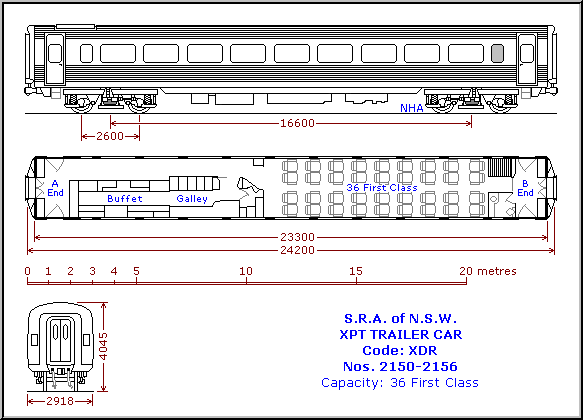
Click thumbnail to
view full size image
|
Day-Nighter Sitting Car with Buffet (1984)
Code: XDR
Numbers: 2150-2156
XDR 2154-2156 were built as part of the second rolling stock order (1983/84). The XDR followed a similar arrangement to the XBR with the
buffet at the A End and a passenger saloon seating 36 in 2 x 2 reclining and rotating seating at the B End. 2150-2153 were converted from XBR
in 1989. All were refurbished and recoded to XBR in 1994.
|
|
|
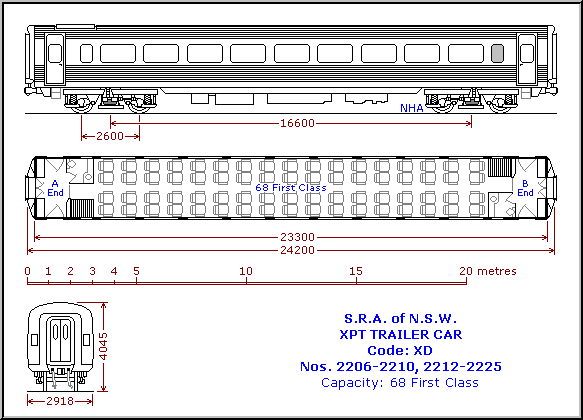
Click thumbnail to
view full size image
|
Day-Nighter Sitting Car (1984)
Code: XD
Numbers: 2206-2210, 2212-2225
XD 2212-2213 were built as part of the second rolling stock order (1983/84) and accommodated 68 in 2 x 2 rotating and reclining seating.
The XD followed the same general arrangement as the XF with entrance vestibules, toilets and luggage racks at both ends and a single passenger
saloon. XD 2206-2210 were converted from XF 2206-2210 when their seating was swapped with that in XDH 2104-2110. XD 2214-2225 were built as
part of the third rolling stock order (1986/87).
|
|
|
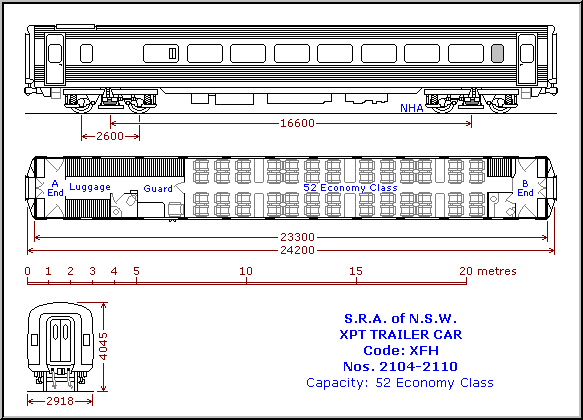
Click thumbnail to
view full size image
|
Second Class Sitting Car with Guard's Compartment (1985)
Code: XFH
Numbers: 2104-2110
From 13 August 1985, two class travel on the XPT was introduced and trailers XDH 2104-2110 had their rotating 2 x 2 seating replaced with
fixed 2 x 2 seating from Economy Class trailers XF 2206-2210 and were recoded XFH. The "D" type seating that was removed was redeployed in
XF 2206-2210.
|
|
|

Click thumbnail to
view full size image
|
Day-Nighter Sitting Car (1988)
Code: XM
Numbers: 2206-2210 and 2212
During 1988, XD 2206-2210 and 2212 were recoded XM. The car configuration remain unchanged and
the reason for choosing the XM coding in unknown.
|
|
|

Click thumbnail to
view full size image
|
Sleeping Car (1993)
Code: XAM
Numbers: 2175-2182
With the planned introduction of the overnight Melbourne XPT in 1993, it was proposed
provide sleeping accommodation on the Melbourne, Brisbane and Murwillumbah services for the first
time in the XPT Fleet. As part of the fourth rolling stock order, eight XAM sleeping cars were
ordered from ABB. This provided two XAM for each of these three services plus two spare cars. The
XAM was a Mann type sleeper with transverse berths and had nine twin berth cabins for overnight
services, while they could seat up to 27 First Class passengers for daylight travel. Each cabin was
2 metres long. Individual shower and toilet facilities were not provided in each cabin and these
facilities were shared between two cabins. Space for the car attendant was provided in a full width
compartment at the A End of the car. The XAM replaced an XFH car in the train consist.
|
|
|

Click thumbnail to
view full size image
|
First Class Sitting Car (1993)
Code: XL
Numbers: 2228-2236
As part of the fourth rolling stock order in 1993, five deluxe sitting cars (2228-2232) were
built by ABB in Dandenong, Victoria. The XL type followed a similar layout to the XB/XD/XF cars with
entrance vestibules, toilets and luggage racks at both ends and a single passenger saloon. The
luggage racks provided at the A End were larger than in the other types. The XL seated 56 in 2 x 2
reclining and rotating seating. XL 2233-2236 were rebuilt from XDH 2100-2103 as these became
surplus due the introduction of the XAM cars. XL 2228-2232 are fitted with the later NMA bogies,
while the others have the original NHA bogies. Seat spacing is 1067 mm.
|
|
|

Click thumbnail to
view full size image
|
First Class Sitting Car (1993)
Code: XB
Numbers: 2200-2209
XF 2200-2205 and XM 2206-2209 were refurbished by Goninan in 1993 as new First Class cars. They
seated 68 First Class and new seating and interiors were provided. The cars were recoded XB. These
cars were later recoded as Economy Class (XF) in 1994. Seat spacing is 1000mm.
|
|
|
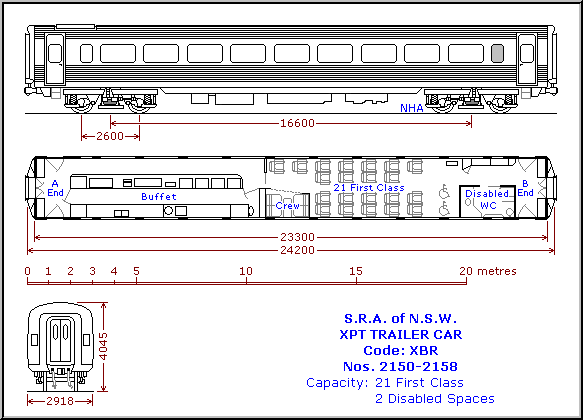
Click thumbnail to
view full size image
|
Second Class Sitting Car with Buffet (1993)
Code: XBR
Numbers: 2150-2158
The existing XDR buffet cars (2150-2156) were rebuilt by Goninan during 1993 and featured a new
buffet layout. A mock up of the new layout was fitted to MFH 2075 before construction was commenced.
These cars seated 21 First Class and also provided accommodation for two wheelchair passengers. A
wheelchair accessible toilet was also provided in the B End. Two additional cars XBR 2157 and 2158
were converted from XD 2225 and XDH 2111 respectively by Goninan in 1993. Seat spcaning is
1000mm.
|
|
|
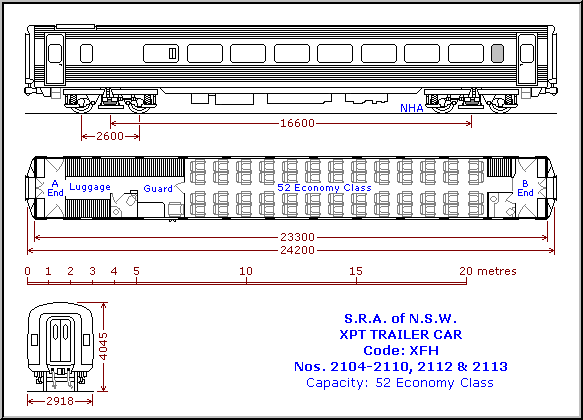
Click thumbnail to
view full size image
|
Second Class Sitting Car with Guard's Compartment (1993)
Code: XFH
Numbers: 2104-2110, 2112 and 2113
The replacement of the Guard's position by the Passenger Services Supervisor (PSS) on XPT
services in 1989 and the introduction of the XAM cars removed the requirement for two vehicles with
Guard's and luggage accommodation on the long distance overnight services. The XAM car provided
suitable accommodation for the PSS in the sleeping car attendant's compartment. These vehicles were
fitted with new seating and refurbished interior. They seated 52 Economy Class and were recoded
to XFH. Seat spcaning is 1000mm.
|
|
|

Click thumbnail to
view full size image
|
Second Class Sitting Car (1994)
Code: XF
Numbers: 2200, 2202-2222, 2224
XM 2210, XF 2211, XM 2212 and XD 2213-2224 were refurbished by Goninan in 1993 as new Economy
Class cars and were the same as the former XB type. They seated 68 Economy Class and new seating and
interiors were provided. The cars were recoded XF. XB 2200-2209 were recoded to XF in 1994. XF 2201
was converted to XAM 2183 and XF 2223 was converted to XL 2237 in 2021. Seat spacing is 1000
mm.
|
|
|

Click thumbnail to
view full size image
|
Second Class Sitting Car with Guard's Compartment (2005)
Code: XFH
Numbers: 2104-2110, 2112 and 2113
The luggage capacity was increased and the passenger capacity reduced by 8 to 44 Economy class
as part of the 2005 refurbishment program. The internal seating was upgraded by placing new seats,
backs and coverings on the existing seat frames dating from the 1993 refurbishment. Seat spacing
is 1000 mm.
|
|
|

Click thumbnail to
view full size image
|
Second Class Sitting Car with Buffet (2005)
Code: XBR
Numbers: 2150-2158
The passenger seating capacity was reduced by 1 to 20 First class and an additional disabled
space made available as part of the 2005 refurbishment program. The internal seating was upgraded
by placing new seats, backs and coverings on the existing seat frames dating from the 1993
refurbishment. Seat spacing was 1000 mm.
|
|
|

Click thumbnail to
view full size image
|
Sleeping Car (2005)
Code: XAM and XAMB
Numbers: 2175-2178, 2180-2183
The XAM was a Mann type sleeper with transverse berths and had nine twin berth cabins for overnight
services, while they could seat up to 27 First Class passengers for daylight travel. Individual
shower and toilet facilities were not provided in each cabin and these facilities were shared
between two cabins. Space for the car attendant was provided in a full width compartment at the A
End of the car. The interiors were upgraded during the 2005 refurbishment. XF 2201 was
converted to XAMB 2183 in August 2023. The additional "B" in the coding indicates the car has
different bogies to the remaining XAM cars.
|
|
|
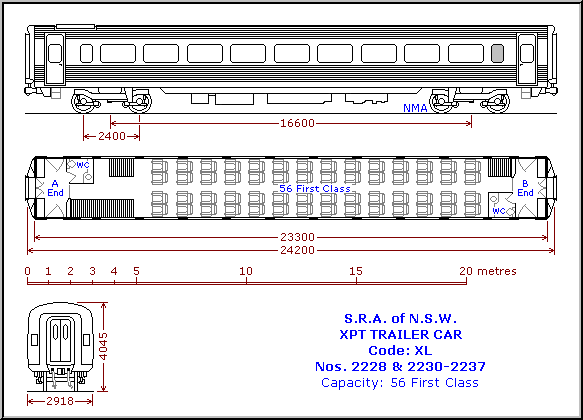
Click thumbnail to
view full size image
|
First Class Sitting Car (2005)
Code: XL
Numbers: 2228, 2230-2237
The internal seating and interiors were upgraded during the 2005 refurbishment. XL 2237 was converted
from XF 2223 in 2021. Seat spacing in these cars is 1067 mm.
|
|
WALLAN DERAILMENT
On 20 February 2020, ST23, NSW Trainlink Melbourne XPT derailed at Wallan (Victoria) Crossing Loop. The train consisted of XP 2018
(leading)-XAM 2179-XL 2229-XBR 2155-XF 2201-XFH 2108-XP 2018 (trailing). XP 2000 rolled onto its side resulting in the death of the
driver and the accompanying Pilot. 39 of the 153 passengers and five other crew members on board sustained injuries. The section from
Kilmore East to Donnybrook over which ST23 was operating had suffered earlier bushfire damage and was working under an alternate
safeworking system with the driver accompanied by a pilot. Temporary operations through the Wallan interlocking ran through on the main
line, however, on the day of the accident ARTC decided to reroute traffic via the loop. The preliminary report indicates that, as ST23
approached Wallan at line speed (130 kph), the driver made an emergency brake application just before entering the loop. The train was
travelling in excess of 100 kph at the time and was unable to negotiate the 15 kph turnout which resulted in the drailment. The five
passengers derailed with only the trailing power car remaining on the track. The investigation by the Australian Transport Safety Bureau
(www.atsb.gov.au) is continuing.
COLOUR SCHEMES
In 1981, the XPT appeared in a new colour scheme for NSW of red, black and yellow. The passenger trailers were predominantly in their
natural stainless steel finish. A broad black band was painted along the window line, with a narrow yellow lining at the top and bottom
of the black band. In common with the power cars, the undercar skirts below the floor level were finished in red.
In 1995, the original colour scheme was replaced by a new Countrylink corporate livery of light blue, dark blue and white. The scheme
for the passenger trailers consisted of a broad dark blue band along the window line, relieved by two narrow lines of white and light
blue towards the bottom of the dark band. The undercar skirts below the floor level were white. This colour scheme was also applied to
the Xplorer rail cars.
A new RailCorp Corporate Scheme of primarily dark blue with turquoise, yellow and white lining was applied to XP 2001 and this unit
re-entered service in February 2005. The passenger trailer scheme has been simplified with a broad turquoise band at the window level
with black undercar skirts below the floor level. Passenger access doors have been painted a bright golden yellow, while other doors, such
as the luggage compartment have the broad turquoise band at the window level carried through. The car ends have been changed from light grey
to dark blue. This scheme is also applied to the Endeavour, Xplorer and Hunter rail cars.
|
Date
|
Colour Scheme
|
|
1983
|
Red, black and yellow
|
|
1995
|
Dark blue, light blue and white
|
|
2005
|
Dark blue, turquoise and yellow
|
REFERENCES
- "Rail Motors and XPTs" by David Cooke (Australian Railway Historical Society - 1984)
- "The Countrylink XPT Refurbishment" by Peter Clark (Railway Digest - July 2006)
- The XPT Page on the RailPage web site (www.railpage.org.au)
- Drawings by Bruce Agland
|
![]() lease refer to the XP Class page for basic information and history about the Express Passenger Train.
lease refer to the XP Class page for basic information and history about the Express Passenger Train.

















